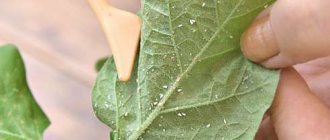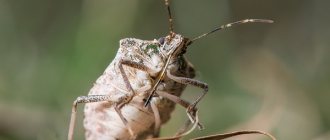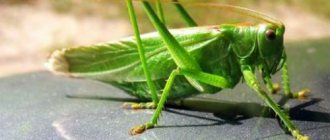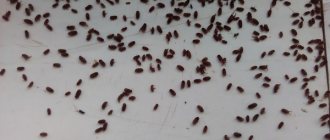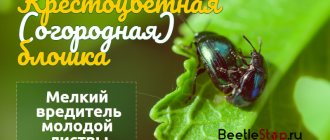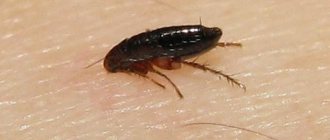It is almost impossible to develop a root crop variety that is resistant to all pests and diseases. Carrots are also not immune to various misfortunes.
To get the maximum possible harvest of this tasty and healthy vegetable and preserve it until spring, you need to know about the most common pests and measures to combat them.
Most often, carrots cause harm:
- carrot fly,
- carrot psyllid,
- naked slugs, carrot aphids,
- carrot moth,
- fall armyworm,
- wireworm
carrot fly
The most common pest of carrots. The insect is a small (up to 5 mm in size) fly with a shiny body with a metallic tint, a red-brown head and transparent wings. The fly emerges in the last days of May. The insect is most active in the evening and at night.
After several young carrot leaves appear, the female lays about a hundred eggs near the very base of the plant. The larvae emerging from the eggs are up to 7 mm in size and have a light yellow body.
They feed on carrot pulp, gnawing out convoluted passages in the root crop. Affected plant
acquires rigidity, an ugly shape and a bitter taste. Rot easily penetrates into the resulting holes. Such carrots can neither be eaten nor stored. By gnawing leaf cuttings, the larvae cause the tops to wilt. In this case, the green color of the carrot leaves changes to red with a purple tint.
The main ways to protect against carrot flies are prevention. The area of soil affected by the carrot fly last year is covered with non-woven material. Open the garden bed only for watering and fertilizing. Warming the seeds before sowing increases their resistance to the pest. In the twentieth of May, the soil needs to be loosened, hilling the heads well and compacting the soil around the stems.
Damaged plants need to be removed, while immediately removing the tops from the garden bed so that they do not attract insects with their smell.
They develop in the ground, so the use of any drugs will not be effective. Another way to combat carrot flies is repelling them. To repel flies, you can plant tagetis, dill, onions, and cilantro next to the carrot beds, sprinkle ash and tobacco dust in the rows between the carrot beds, and bury healthy tomato tops on the bed itself. After harvesting, the soil is dug deeply.
Preventive measures when growing carrots
Tired of fighting carrot flies, aphids and psyllids year after year? Then take into account the following recommendations:
- plant carrot varieties that are resistant to diseases and pests;
- Before sowing, treat the seeds in a solution of potassium permanganate;
- choose a sunny place for planting carrots, without stagnant moisture;
- sow carrots as early as possible, when the soil warms up to 5°C, or practice winter sowing;
- Late sowings (twentieth of June), when the flight of the cabbage fly stops, will also be effective;
- do not thicken the plantings and thin out the plants (in the phase of two true leaves and after three weeks, when the tops reach about 10 cm in height);
- observe crop rotation: plant carrots in their original place no earlier than after 4 years;
- follow the regime of watering and fertilizing carrots, use warm water for watering;
- periodically spray the plantings with nettle infusion or biological products (Fitosporin-M, Gamair, etc.);
- get rid of ants and anthills;
- after harvesting, do not leave the tops on the beds, but put them in compost;
- plant onions, garlic, marigolds or calendula near the carrot beds;
- Weed regularly, especially dandelion and clover, which attract carrot flies;
- sprinkle the soil with wood ash, ground pepper or tobacco to repel pests;
- Before storing carrots, treat the storage with disinfectants;
- Do not injure the leaves of plants during weeding, so as not to attract pests and not open the way to infections.
Don't give pests a chance to ruin your harvest! Read about other problems that may accompany growing carrots in our articles:
- 6 common problems that may arise when growing carrots
- 3 main questions about green carrots, or Why carrots are bitter
- Everything about growing carrots - detailed instructions for beginners
Carrot leaf flea beetle (psyllid)
Infection of carrots with psyllid can be identified by the curling of the leaves, which become terry, reminiscent of parsley leaves. Leaf growth stops, root crops harden and dry out. The carrot psyllid is a small insect up to 2 mm in length with a delicate light green color. Has transparent membranous wings, red
eyes, long thread-like antennae. The hind legs are adapted for jumping.
During the year, the insect produces one generation. After overwintering on pine trees or wild carrots, female flea beetles lay white spindle-shaped eggs on garden crops, which turn yellow over time. The larvae emerging from the eggs feed on the sap of the plant.
Measures to combat carrot psyllid include destroying wild carrot crops and isolating the garden from coniferous trees. The crops are treated with daily tobacco infusion (1 kg of tobacco waste per bucket of hot water). Before spraying the plants, filter the infusion and add about 30 g of soap to it. Among the chemical preparations used are Actellik, Arivo, Decis, Tsimbush, Sherpa, Sumitsidin in accordance with the instructions supplied with them. A month before eating carrots, spraying is stopped.
Whitefly
The insect got its name because of its light wings. Whiteflies can be found on the back of leaves. It feeds on the sap of the plant, gradually destroying it. A trap will help to catch the pest: paint a plate measuring 15x15 cm yellow, spread a layer of honey or molasses to attract whiteflies, fix the plate between the beds. Insects will flock to the color and aroma, but keep in mind that pollinating insects may fly to the smell, so instead of honey, a layer of Vaseline is allowed.
Whitefly
The drug Admiral will help destroy the larvae; Aktara or Fitoverm will act on adult whiteflies.
Preventing the appearance of whiteflies is to plant calendula, garlic, and yarrow along the rows. Ladybugs will become a natural protector of carrots; they eat not only whiteflies, but also other small insects.
Naked slugs
They harm seedlings and adult plants, and do not disdain even sown seeds. Danger
for carrots, both adults and juveniles are represented. Slugs mainly live in the ground, under stones, fallen leaves and other places with moist soil.
The naked slug has an elongated, smooth body reaching 6 cm in length. The head resembles the head of a snail. Mollusks reproduce throughout the summer and throughout the fall. The female lays heaps of five thousand eggs in secluded damp places. Transparent eggs resemble fish eggs. After 2–3 weeks, young slugs hatch from the eggs and become adults within a week.
These pests multiply especially in large numbers in rainy summers, because moisture is vital for them.
Active at night and on cloudy days. They overwinter in the egg stage.
The fight against slugs is helped by regularly clearing the area of weeds. Tops, mowed leaves, and harvested plants must be removed from the beds. It is advisable to drain roadside ditches. The infected area is treated with a 30% lime solution, after adding ash at the rate of 250 kg per hectare of land, or superphosphate at the rate of 300 kg per hectare. Plants are sprayed with 10% saline solution. The procedure is carried out at night when the slugs are active.
Methods for controlling insect pests of carrots.
Whether you get a harvest in the fall or not depends on high-quality and timely measures. Among the insects listed above, there are those that are very difficult to fight, but there are also those that disappear after taking the first measures.
•How to deal with carrot flies.
If you notice the first signs of a carrot being damaged by a fly, then you urgently need to treat the area with broad-spectrum insecticides. Also, this pest does not tolerate ash. You can use a folk method that will give the fly a “light” - this is tobacco. It must be poured over the beds. The experience of vegetable growers shows that the carrot fly cannot stand the smell of tobacco and soon leaves the area.
•How to deal with psyllids.
It is very difficult to get rid of this pest, as they quickly change their location due to their mobility. Various chemicals can be used, but when one flock leaves the territory, another soon takes its place. The psyllid also does not like the smell of tobacco. Oranges are another option. Tobacco and orange peels are soaked in water, infused and sprayed on the seedlings. Also, after the carrots have sprouted, they need to be covered with argo fiber for two weeks.
•How to deal with fall armyworm.
The armyworm is most afraid of insecticides; they kill the entire flock of butterflies, preventing their future invasion. You can use a drug such as “Sherpa” and “Fury”. Treatment is tedious once every 2-3 weeks.
•How to deal with mole crickets.
Fighting this pest is not easy. The mole cricket's passages are destroyed by plowing and deep loosening for the entire period of vegetable ripening. Another way is to fertilize the area with chicken droppings, since the mole cricket does not like its smell and avoids it. Marigolds are also disgusting to this insect. By planting them around the perimeter, you can scare away the mole cricket from the area. Many people use experiences such as using film or plastic. Along the entire perimeter, you can use plastic inserts that sink 15-20 cm into the ground and prevent the mole cricket from penetrating. She hits an obstacle and changes her path. Drugs designed to combat this insect are also used.
•How to deal with wireworms.
It's quite easy to fight him. The wireworm does not like ammonia, so it is worth fertilizing the soil with preparations that contain it. Another remedy is “Bazudin”. The solution is prepared at the rate of 15 g. the products are mixed with sand and then scattered over the entire surface where the wireworm has settled.
- Pests and diseases of carrots
•How to deal with willow-carrot aphids.
Aphids do not like all drugs that have a strong odor. Therefore, tobacco, pepper, wormwood, and garlic can be used as a deterrent. Infusions are made from them and the pest location is sprayed. There is also a drug called Pyrethrum, which actively fights willow aphids.
carrot aphid
Unlike naked slugs, they are dangerous if the summer is dry. Aphids prefer to live on the underside of the leaf and, when damaging it, suck out the sap. The leaves curl, their growth slows down, and the carrot yield decreases. An individual aphid has a length of up to 1.7 mm. Her antennae are half as long as her body.
There are two generations of aphids - wingless and winged. Wingless aphids are born from eggs overwintered on wild carrots. They have a light green body and a brown head. After 2–3 generations, winged aphids hatch. They have a black head and chest. The upper part of the abdomen is green. Winged aphids fly to cultivated carrot crops. Aphids live at the base of leaf petioles in large colonies.
To combat carrot aphids, wet leaves are dusted with sifted ash or a mixture of ash and tobacco dust in equal parts. 20 minutes after dusting, the soil is loosened. You can spray a vegetable crop with a fermented infusion of any herb, including weeds. It is important to destroy weeds and remove them from the beds, alternate sowings of different crops, and dig the soil deeply in the fall. Carrot aphids are also repelled by marigolds planted on both sides of the bed.
Medvedka
It’s unlikely to miss a mole cricket in the garden. The insect, up to 5 cm in size, is brown in color, has powerful front legs and teeth that allow it to dig the ground. The insect has wings, but it does not fly short distances. The mole cricket takes root in humid areas near lakes and rivers, preferring soils enriched with humus. To continue the genus, the pest digs holes where it lays eggs from mid-May to the end of August.
Medvedka
The mole cricket feeds mainly on the stems and roots of plants, and also does not disdain small invertebrates, such as earthworms.
It is worth fighting mole crickets with chemicals if their numbers cause damage to the gardener. Preparations:
Prevention of occurrence is deep digging of the soil.
Carrot eaten by a mole cricket
Carrot moth
An adult butterfly reaches 18 mm in size. The front wings are dark brown in color, the hind wings are grayish-pink. The chest and head are colored light yellow. Butterflies fly out in the second half of June. They lay greenish eggs on the inflorescences of the plant. The caterpillars emerging from the eggs grow up to 13 mm long, have a black head and a brown body with a pinkish tint, along which there are white tubercles. Moth caterpillars secrete cobwebs that entangle the inflorescences and umbels of the plant, thereby damaging them. The caterpillars pupate in August, and after some time the second generation moth appears.
They fight carrot moths with chemical and biological preparations (lepidocide, dendrobacillin, entobacterin, etc.), herbal remedies, treating inflorescences with them during budding. It is useful to mow umbrella weeds, destroying plant debris. Prevention measures also include early harvesting of carrots followed by threshing of the seeds.
Garden and umbrella moths
The umbrella moth is otherwise called carrot or dill moth, since the butterflies begin their massive flight during the period of active growth of the tops.
It is the larvae that are destructive that the moth lays in the inflorescences of the seed plants of the crop. As the larvae grow, they eat plants and remain in the inflorescences for a long time. If 4-5 caterpillars appear on the plantings, then the pest should be destroyed with biological products.
The caterpillars secrete a web, which causes the umbrellas and inflorescences of the carrots to tighten, forming a cocoon. In the same web, the moth lays offspring, which the gardener does not immediately detect.
Preventing moths:
- timely harvesting of testes;
- regular weeding of beds;
- cleaning damaged inflorescences;
- destruction of wild plants (especially hogweed).
If 1-2 umbrella moth caterpillars are found on carrot plantings, they can be collected manually without using chemicals. The vegetable moth takes root in the southern regions, in particular in the Caucasus, Krasnodar and Crimea. In warm places, moths leave 2-3 generations per season.
If the need to use insecticides does arise, then this must be done a month before harvesting vegetables.
Preparations:
- Voliam Flexi - on average, 2 treatments are required;
- Lepidocide;
- Aktellik;
- Enterobacterin.
Among the folk methods, umbrella moth can be overcome by spraying with a soap-ash solution, onion broth, garlic broth, or wormwood solution.
Fall armyworm
The caterpillars of this butterfly gnaw the petioles of the leaves of carrots and other vegetable crops, as a result of which the plants die. The caterpillars also spoil the root crops themselves, impairing the taste.
quality of carrots. The moth has a wingspan of about 3.5–4.5 cm. The front wings are gray-brown, the hind wings are white. The caterpillar reaches 5 cm in length. Has a dark stripe along the back. It overwinters in the ground at a depth of about 25 cm. It pupates in mid-spring, and adult butterflies emerge from the pupa in early summer. Female cutworms are very fertile. One female can produce up to 2 thousand caterpillars per season.
The winter armyworm is repelled by the smell of chamomile, burdock, and yarrow. Decoctions of these plants can be sprayed on carrot tops. Early sowing and optimal plant density in the garden bed reduce the risk of fall armyworm infection. During the egg-laying period, the release of Trichogramma is quite effective at the rate of 35 thousand copies per 1 hectare of crops. Insects are released three times after 4–5 days, then again when the caterpillars pupate.
The death of approximately 85% of pests is caused by abundant sprinkler irrigation. Biological products used include lepidocide con, Polytrin, Arrivo, Fury and others. Processing is carried out in the evening.
Onions are a fairly easy-to-care plant, but numerous onion pests can ruin the harvest. The greatest danger to cucumbers, eggplants and zucchini are the larvae of the cucumber mosquito. Read about ways to protect yourself from insects in this article.
Gypsy moth caterpillars are capable of destroying large forest areas. You can read detailed information about pests for more effective control at the link.
Carrot diseases
Black rot, or Alternaria. The causative agent is the fungus Altemaria radi-at MD et E. from the class of imperfections.
Distributed everywhere, especially in areas with sufficient moisture. The disease appears more often on carrots, less often on parsley, celery and some wild plants of the Apiaceae family. Seedlings, older plants, as well as root crops during storage are affected.
Infection of root crops occurs through damage during digging and transportation of carrots. Dry depressed spots form on the root crops (on the side or on the top). When an incision is made at the site where the spot forms, a coal-black color of the affected tissue is visible.
The special value of carrots, like other root vegetables, is that they can be stored and consumed fresh until the next harvest.
Carrots are used for cooking raw and boiled, they are canned, dried, carotene and juice are obtained from them, and are used for medicinal purposes, dietary and baby food, in perfumery and the confectionery industry.
Carrots are the main source of carotene (provitamin A), which in the human body turns into vitamin A. The carotene content in root vegetables ranges from 7 to 36 mg% (special selection varieties average 9-10 mg%). Compared to other sea vegetables
On seed plants whose roots are affected by black rot, the stems and inflorescences wither, which predetermines a shortage of seed yield.
During storage, the disease develops slowly and does not cause much harm.
The source of infection is infected seeds collected from affected areas and the soil from which the fungus is brought into storage. The fungus overwinters with mycelium and conidia.
Fomoz, or brown rot. The causative agent is the imperfect fungus Phoma rostrupii Sacc.
The disease occurs in the central and southern regions only on carrots.
In carrot crops of the first year of cultivation, the disease appears in the second half of summer in the form of elongated grayish-brown stripes or oblong spots on the cuttings and leaf veins. Rarely, black pycnidia form in the spots. On root crops, dry black rot often appears near the top.
When storing root crops, their damage intensifies. The spots deepen, white mycelium appears inside them, and small black pycnidia located in groups appear on the surface of the lesion.
On the seeds grown from affected roots, the above-ground mass withers even before the formation of inflorescences. Local damage to the stems and inflorescences of the testes is often observed; grayish-brown spots with small pycnidia form on them.
Humidity has a great influence on the development of the disease and its spread. In years with high rainfall, significant seed damage can be expected.
The source of infection is the affected roots, which are planted on the seeds, infected unrotted plant debris and infected seed.
Damage from the disease: loss of seedlings, reduced seed yield and deterioration of their germination, unsuitability of roots for storage and increased rot during this period.
Rhizoctoniosis, or felt rot. The causative agent is an imperfect fungus Rhizoctonia violacea, which develops vegetatively in natural conditions. Can persist in soil for a long time.
The disease is more common in the central and northwestern parts of Ukraine on carrots, parsley, beets and other crops; can also develop on some weeds, in particular on nettle, quinoa, thistle, chickweed, etc.
It begins to appear on carrot roots even during growth in the field in the form of gray-lead subcutaneous spots, which then sink in and become covered with a purple-brown felt coating, on which small black pseudosclerotia are sometimes visible. When the roots are damaged during the growing season of plants, their leaves turn yellow and dry out. Under conditions of winter storage of root crops, the development of the disease continues.
In the field, rhizoctonia appears in cells. The disease develops more strongly on acidic, moist soils with insufficient aeration.
The source of infection is contaminated soil and affected root crops.
White rot, or sclerotinia. The causative agent is the marsupial fungus Sclerotіnіa sderotіorum. The disease is widespread, especially in areas with high humidity. It affects root crops of almost all vegetable crops, most industrial and ornamental crops, as well as many weeds.
White rot is very harmful and can cause massive wet rotting of root crops during storage, but is especially harmful to the seeds, causing their death. Usually develops in nests, with dense plantings in low places.
It manifests itself in the formation of a white felt coating in places of rotting. Later, hard black sclerotia form on the plaque, which remain viable for a long time.
The causative agent of the disease overwinters in the form of sclerotia. In spring, sclerotia germinate and form either mycelium, which penetrates the plant, or apothecia - saucer-like bodies on cylindrical legs. The upper part of the apothecium consists of a layer of tightly seated bags, which contain 8 elliptical colorless bags. Depending on the size of the sclerotium, from 1 to 5 apothecia can form on it, and on the ethmoidium - from 10 to 40 apothecia. Typically, the germination of sclerotia with the formation of bags with sacspores lasts 30-38 days from the beginning of spring field work.
The saccospores germinate and form a mycenial shoot that penetrates the plant.
The source of infection is the soil in which sclerotia and mycelium of the fungus remain on the affected remains.
Gray rot. The causative agent is the imperfect fungus Botrytis cinerea Pers.
It is widespread and affects almost all vegetable, industrial, flower and ornamental crops.
It mainly affects carrot seeds and root vegetables during storage, especially when they are stored together with cabbage and celery, which are highly susceptible to this disease. Weakened root crops are most affected. A grayish fluff appears on them with sporulation of the causative agent of the disease. Over time, black fungal sclerotia of various shapes and sizes form on the affected root crops. Affected root crops rot.
The main source of infection is the soil, in which the fungus can survive in the form of sclerotia on infected plant debris and be carried into storage.
Wet bacterial rot of vegetables. The causative agent is Erwinia carotovora (yones) Holland.
It is widespread and affects various vegetable crops, in particular carrots, cabbage, potatoes, rutabaga, etc.
It can appear even in the field, with watery spots forming on the tail part of the roots, which then wrinkle. Affected plants wither.
During storage, light brown spots first appear on the surface of the root head. The affected tissue loses strength and turns into a shapeless slimy mass with an unpleasant odor.
The defeat occurs during the collection and storage of carrots.
The source of infection is contaminated plant debris.
Wireworm
They are the larvae of different species of click beetles. It looks like a hard yellowish worm about 3 cm long. The beetle got its name because when you try to put it on its back, it quickly turns over, bending its cephalothorax and making a loud click. The lifespan of one generation is about 5 years. The wireworm is polyphagous. He enjoys beets, buckwheat, potatoes, carrots, grains, flax, and legumes. Favorite plant is wheatgrass. In the root crops of carrots, beets and potatoes, convoluted passages are formed, which leads to mold and rot. The wireworm moves easily in the ground.
The optimal soil moisture for the development of wireworm larvae is about 50% at a temperature of 20 degrees Celsius.
When humidity is high, the larvae rise to the surface. When the soil dries, it deepens to a depth of 1 m. The female lays eggs from May to July. After 3 weeks, young larvae appear. In the first year of life, their length is up to 7 mm. In July-August the larva makes itself
lies in the soil and pupates. In the spring, overwintered beetles emerge from the pupae.
Fertilizers containing ammonia and soil liming are effective in the fight against wireworms. Before sowing, carrot seeds must be treated with insecticides. Bait crops are also used, in which the seeds are treated with insecticides. We should not forget about thoroughly loosening the soil, weeding weeds (especially creeping wheatgrass), and attracting birds that peck the larvae. Among chemical preparations, “Bazudin” and “Aktara” are used; among biological preparations, “Etonem-F” is effective. When digging a site deeply, it is good to add ammonium sulfate or ammonium nitrate at the rate of 20–30 g per 1 m2.
Many factors influence the health of carrots. The best control measure is prevention; in particular, it is necessary to disinfect the seeds before sowing. It is important to maintain a balance in the amount of fertilizer applied to the soil. An excess of nitrogen fertilizers contributes to an increase in diseases, and an excess of phosphorus-potassium fertilizers, on the contrary, increases the immunity of carrots to diseases. It is imperative to observe correct crop rotation: swap crops, dig the soil deeply. If pests are identified, it is necessary to immediately take measures to destroy them.
The main causes of infection and the appearance of parasites
In order to make it easier to protect the future harvest, first of all, it is necessary to understand what factors increase the likelihood of crops being damaged by the most dangerous pests. By eliminating these causes, as a rule, it is possible, if not to completely get rid of future problems, then at least to reduce their threat to a minimum.
So, the appearance of pests in a carrot bed is facilitated by:
- Violation of crop rotation rules . Growing identical or related crops in one place for several years in a row leads to the fact that parasites, having discovered their favorite delicacy last year, safely overwinter in the soil, and in the spring, upon awakening, they immediately find themselves in an environment favorable for mass reproduction. In addition, during the season, plants extract from the soil exactly those useful substances that they primarily need, so the soil, when planting crops of the same type, becomes poorer from year to year and becomes completely unfavorable for them. Carrots, in particular, cannot be planted after cumin, celery, coriander, potatoes, and turnips. Cabbage, as well as peas, beans and other legumes, are good precursors for such crops.
- Planting density . Many pests feel comfortable in dense thickets, where they cannot be reached by birds of prey and are not disturbed by the wind and scorching rays of the sun.
- Incorrect soil composition . A neutral or slightly acidic environment is suitable for carrots; with increased acidity of the soil, the plant develops poorly and gets sick, and some parasites, for example, wireworms, on the contrary, feel great in such soil.
- Waterlogged soil . Increased soil moisture is a favorable habitat for not only fungal infections, but also many other soil parasites.
- Weeds . Extraneous grass in the garden draws nutrients from the soil, obscures the light of the cultivated plant, but, in addition, is suitable food and a kind of “reservoir” for some pests. In particular, the already mentioned wireworm cannot harm root crops during the first year of life, but happily eats the roots of weeds growing nearby. If there is sufficient food, by the next year the larva grows, gets stronger and begins to destroy the crop with incredible speed.
- Ants . These indestructible and ubiquitous insects themselves do not cause harm to agricultural crops, but are active carriers of aphids (the word “carrier” in this case is used in the literal sense, since the ants plant aphids on plants purposefully: the honeydew secreted by this parasite is the ant’s favorite delicacy ).
- Poor seed quality . Insects experience the unfavorable and hungry winter time in different ways. Many of them pupate and overwinter in the soil, while others penetrate into the seeds. After the seed germinates, the parasite becomes active and infects the crop at a very early age.
- Genetic instability of a variety to one or another parasite . Year after year, breeders develop new varieties and hybrids of carrots, while in the process of selection and various types of crossings, scientists try to consolidate various beneficial properties in the new generation, including immunity to various pests. It is important to take this feature into account when choosing a variety, focusing on those problems that are most characteristic of a given area. Thus, the carrot fly is practically not dangerous for such varieties as Perfectsiya, Flacco, Olympus, Nantes, Vitaminnaya; among the hybrids, Kalgeri F1 is resistant to this parasite.
Did you know? The use of chemicals to control insect pests has come under increasing criticism among scientists in recent years. Thus, it is estimated that in the last half century alone, at least 2.5 thousand species of parasites have appeared in the world, showing complete resistance to the action of one or another pesticide, which was previously considered effective.
Some agrotechnical tricks help reduce the likelihood of carrots being damaged by pests, for example:
- planting plants in close proximity to the garden beds, the smell of which repels harmful insects;
- regular loosening of the soil during the season, as well as deep digging before winter and early spring (larvae and pupae located in the ground, once on the surface, die from the sun, frost or are pecked by birds);
- covering the bed with fabric during the period of active oviposition of the most characteristic parasites for a given area (the purpose of such an event is to physically prevent adults from approaching the plant);
- choosing the time for planting and harvesting in such a way that during the period of maximum parasite activity the root crops are inaccessible to them (not yet planted or already harvested).
Treatment of carrots and beets from pests during the growing season
Not only diseases, but also pests cause great damage to the future harvest of carrots and beets. Among them are carrot fly, beet flea beetle, slugs, beet leafminer, carrot psyllid, root-knot nematode, mole cricket, etc.
On root crops of early ripening varieties, it is worth abandoning the use of insecticides. It is better to spray the plants with a solution of black pepper and soap (1 tablespoon of ground spice and 10 g of soap per bucket of water). To treat 1 square meter, 1 liter of the resulting mixture is enough.
Carrot fly treatment
photo from inaturalist.org
If a carrot fly has settled in a carrot bed, you can forget about a good harvest. The pest feeds on the plant at all stages of its development: from cultivation to storage. The purple tint of the leaves will tell you about the “violent activity” of the insect. Tortuous passages and transverse cracks appear on root crops.
The carrot fly cannot tolerate the smells of onions and garlic. Planted next to carrots, these crops will discourage the pest from “feasting” on the root crop.
Spraying plants with onion infusion will repel insects: 300 g of chopped onion, poured 2 liters of boiling water, leave for 24 hours. Then strain and dilute with a bucket of water, adding 30 ml of liquid soap to it. Treat carrots and row spacing with this solution.
Another folk remedy for carrot flies is a decoction of tomato tops. Leave 4 kg of tops in a bucket of boiling water for two days. Then add 50 g of liquid soap to the broth and spray the carrot bed.
A mixture of tobacco dust and ash (1:1) has proven itself well against carrot flies: sprinkle it on the soil between the rows 2-3 times per season.
And if these folk remedies do not help, use insecticides Inta-Vir (1 tablet per 10 liters of water) or Iskra (1 tablet per 10 liters of water).
Treatment for carrot psyllid
photo from inaturalist.org
The carrot psyllid damages the beds of the root crop of the same name; the juice from the leaf petioles is sucked out by both adult insects and larvae, thereby inhibiting the plant.
Against psyllids in May or June, use insecticides, for example, Alatar (5 ml per 4 liters of water). Usually one treatment is sufficient. You can repel insects with infusions of orange peels or tobacco dust.
Treatment for umbrella moths
photo from hiveminer.com
Like other umbrella moths, carrots are eaten by caterpillars of the umbrella moth, or carrot moth. They are mainly attracted to flowering mother plants. When buds appear on the testes, the butterfly lays eggs in them. After a week, the larvae will hatch from them and begin to eat the buds and flowers and gnaw the stalks.
The presence of such a pest on carrots is difficult not to notice, because the caterpillars entangle the umbrella inflorescences with their web.
This insect has a natural enemy - the trichogramma wasp, which eats moth eggs. To prevent the pest from causing damage to the carrot mother plants, release the wasps into the garden at the end of April or collect the caterpillars by hand later, cutting off and destroying the inflorescences inhabited by moth larvae.
You can also get rid of insects using insecticides. Treat plants against umbrella moths during the growing season with solutions of preparations such as Fufanon-Nova (13 ml per 10 liters of water), Aktara (8 g per 10 liters of water) or Iskra (1 tablet per 10 liters of water).
Treatment for beet leaf miner
photo from naturespot.org.uk
The peak activity of the beet leaf miner occurs at the end of May - beginning of June, when it lays eggs on the underside of the leaves of the root crop. After 10 days, larvae emerge from them and feed on the pulp of the leaf, making passages in it. Over time, through holes form in place of these passages.
In mid-May, spray the beets with a solution of the insecticide Iskra (1 tablet per 10 liters of water). To repel insects, sprinkle the beds with any ground pepper or mustard. To combat the pest, also use insecticides with the active ingredient beta-cypermethrin, for example, Kinmiks (2-3 ml per 10 liters of water).
Beet flea beetle treatment
photo from fugleognatur.dk
In the spring, the beet flea beetle “feeds” on nettles and sorrel, and in the summer it moves to root crops. The insect eats away the pulp on the upper side of the leaf, but does not touch the lower skin. Such holes resemble translucent windows.
To prevent the appearance of this small pest on beet plantings, treat the sorrel growing next to it with ash. Deep digging of the soil in the fall will prevent the larvae from overwintering under plant debris in its upper layer.
If flea beetles are found on beets, sprinkle the seedlings with ash on wet leaves 3 times with an interval of 5 days. If this does not help, then spray the seedlings with an infusion of tobacco dust and ash, of which you need to take 200 g and leave for two days in a bucket of water.
Then strain, dilute 1:2 with water, add 40 g of laundry soap and process the tops 2-3 times with a break of 5-8 days.
Treatment for root-knot nematodes
photo from aaltjesschema.nl
Small root-knot nematodes are dangerous pests for many plants, including root crops. They parasitize on the roots, leading to the formation of growths of various shapes and sizes on them, which are called galls. As a result, plants cannot eat and absorb water normally, they wither and often die.
Conventional pesticides have no effect on them. Before planting, you can spill boiling water on the soil, but some pests burrow deeper and remain untouched. You can try anthelmintic drugs, for example, Dekaris (1 tablet per 1 liter of water). Pour this solution over the diseased plant several times.
- How to get rid of nematodes on the site: chemicals and folk remedies
Do roundworms indiscriminately destroy all the plants on your property? It's time to start serious pest control!
Mole cricket treatment
Medvedka is a formidable opponent. It lives mainly underground and gnaws plant roots and eats seeds. It also affects beets and carrots, on whose root crops traces of the pest are especially noticeable.
There are many drugs and folk remedies for this pest. The most effective of them - Medvetox (2-3 g per 1 sq.m.), Thunder (3 g per 1 sq.m.), Grizzly (2 g per 1 sq.m.) are introduced into the soil to a depth of 3-5 cm during growing season.
Folk remedies are not as effective, but they are safe for human health and pets. The mole cricket's passages can be filled with soapy water (100 g of laundry or tar soap per bucket of water), infusion of onion peels or a solution of kerosene and water (100 ml of fuel per 1 liter of water).
- How to deal with mole crickets - effective drugs and folk remedies
Don’t know how to get rid of mole crickets on your property? Our recipes will help you protect your garden crops from this underground pest.
Fighting slugs
Slugs damage most garden plants. Beets and carrots also suffer from them, especially their seedlings. Slugs have an excellent appetite and great fertility. If left unchecked, they can significantly reduce vegetable yields.
Collect slugs by hand. After watering the plants, sprinkle the rows with slaked lime or a mixture of lime and ash. You can prepare bait for them from beer or milk, and then collect all the “treats”.

